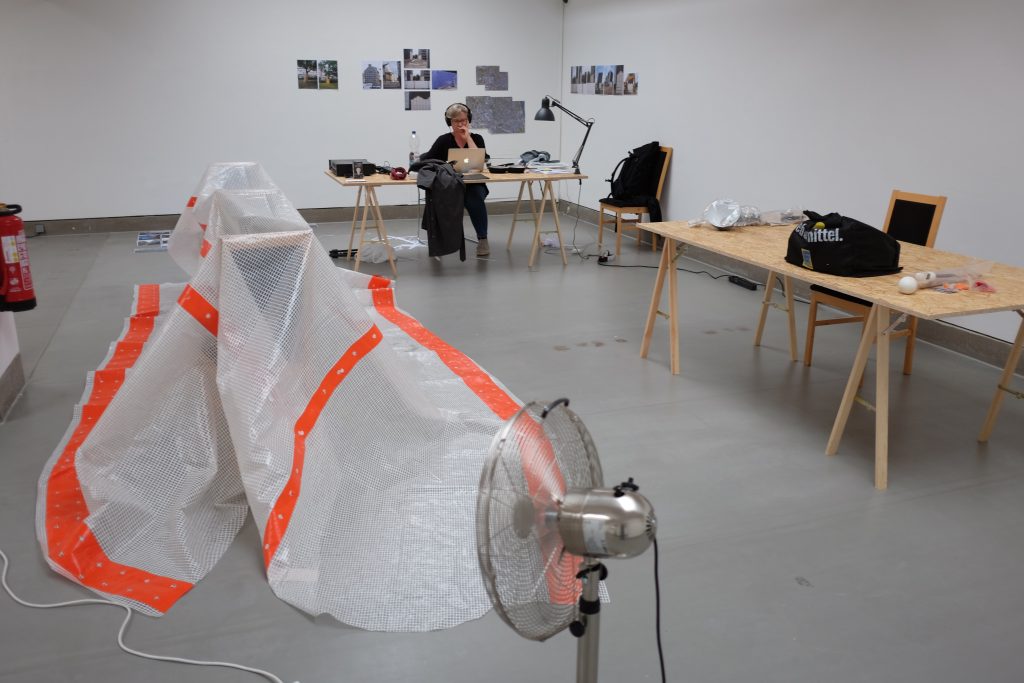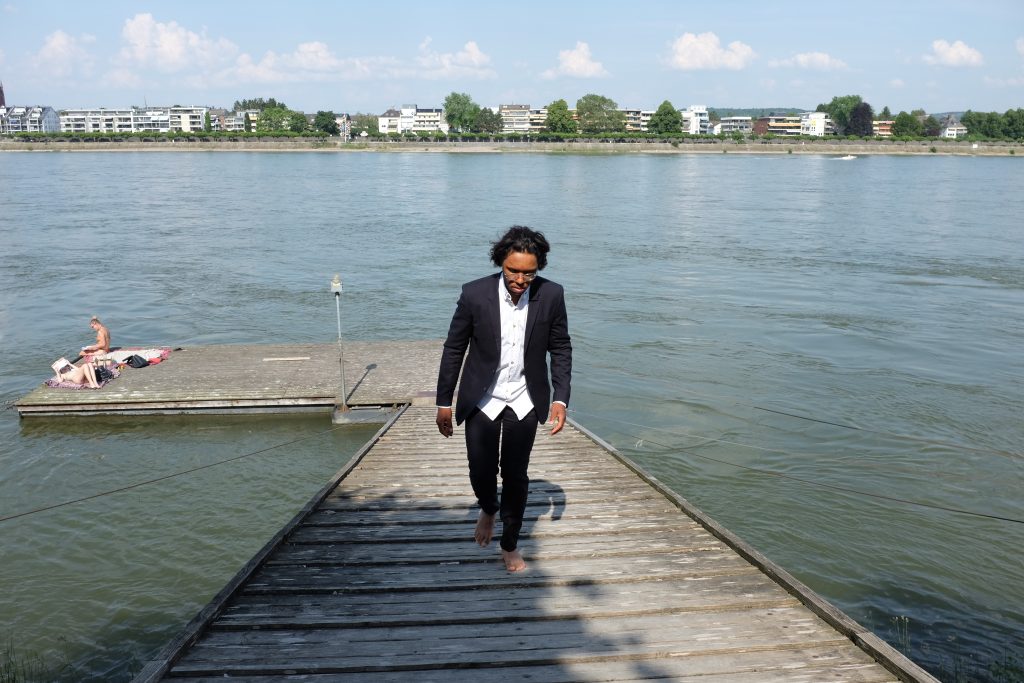
Valparaiso / Bonn
Dates: 10. June – 8. July 2021
Artists: Maurice Pülm, Christiane Wien + Constanza Alarcón Tennen, Michel Poblete Montoya
Mentors: Stefan Rummel (stadtklankünstler bonn 2014) + Fernando Godoy(director Tsonami Festival, sound artist, Valparaiso)
Partner organisation / Residency place:
Künstlerforum Bonn + Tsonami Festival Residency
Supporter: Goethe-Institut Chile
The Eternal Violin, the Blood Moon and Fireflies
an introduction by Stefan Rummel
Our first research trip together by bike takes us from August-Macke-Platz through Bonn’s northwest. First, we pass through a small commercial zone, with building supply stores, auto dealerships and a colossal car wash, more than two stories high. At the end of the street, our little bike parade takes a left, toward the Tannenbusch district, with its old settlement built on a dune, a nature preserve in the middle of the city, inhabited by exotic ring-necked parakeets, among other creatures. We stop briefly on the pedestrian overpass (Tannenbusch Süd): from here one has a 360° view of Bonn. Trains rush past below. I’m reminded of freight trains thundering past at the main station while one waits in the locomotive wind for departure. We ride on to Neu-Tannenbusch and admire the high-rise estate. Is this normal housing here? There’s something depressing about it too, so we decide to head back towards the Rhine again instead, to the „port of Bonn“, where we watch containers being loaded, large things, though in quantities the mind can grasp. The port has a pleasant-looking old brick building, and when light rain begins to fall, we seek shelter in the port cafeteria („bistro parthies [sic], international cuisine in a relaxed atmosphere“). Labourers and office workers come by with their lunch pails, to take their lunches à la carte, while some of them stay to dine. We drink coffee and have something to eat.
Back in the saddle, we head on through Graurheindorf, along a „well-kept pedestrian and bike path on the riverbank, equipped with rubbish bins and benches“. We take the ferry to Graurheindorf-Mondorf and disembark at Mondorf’s Rheinterassen, swans and geese are everywhere. We ride on into a wooded area reminiscent of a primeval forest, with swamp-like waterways, and then the mouth of the Sieg appears. From here, we have to cross a broken-down, barricaded bridge across a branch of the river on our bikes, a mini adventure. In the further area of what’s known as the „Sieg floodplain“, the artists make diverse sound and video recordings: the calm of the landscape (as contrast) and the gentle rustling of the trees and the overgrown fields is interesting here. At the end of our landscape tour, we want to cross the Sieg with the old wooden ferry, but, alas, it is out of service. A man tells us of a possibility to cross the river on foot at a certain spot. We are surprised to hear this and try it out, but the water is too deep and the current too strong.
The „Siegaue“, as a floodplain landscape a further nature preserve near the city, is perfectly structured. The landscape is sophisticated and has a flawless appearance somehow. One has the impression that nothing is allowed to become excessively overgrown, aside from select locations. The landscape has the effect of a landscape painting, with occasional expressive brush strokes. Light wilderness through rewilding. A couple of tree stumps are left lying on the ground, allowed to simply rot, giving way to new life. But we are often subject to the same dilemma of the perception of wellbeing.
It is nice, but it also distracts us from the (other) reality, from things that we cannot or do not want to deal with. I feel like this is where art or artistic practice enters the picture. With its (at times playful) means, art can search for this reality. Art doesn’t have to direct, instead it can open/penetrate and develop, art can show what is missing.
The sonic explorers set off on a journey to find out how they can describe this reality (in individual positions or together, as a group) using familiar mechanisms, learned artistic practice or new strategies developed specifically for Bonn.
With Text, Voice and Illustration, Both Installative and Auditory
Inquiry, Research, Performance:
The challenges were varied. For the two German participants, it was more about the inner search and the ease to reflect. The type of place is familiar (though perhaps the type of project is not). For the two Chilean artists, the „exotic German“ aspects were certainly interesting, to use them to access their inner world, as was, in the end, the possibility to have complete mobility (on foot and by bike). Figuring out what exactly to tackle and then executing the plans were important driving forces for everyone in the end. The sonic explorers project demanded quite a bit of thought from the individual artists, since it is both a research and an exchange project. The artistic form of the final presentation, including the documentation of the research results, is defined by every single decision made by the individuals involved. What sort of risks can I take, how much can I leave aside (of my own ego), should I work like I always do (play it safe) or seize the opportunity to experiment?…
Christiane
In her research, Christiane Wien concentrated on the urban space and the feedback loops it triggers, or the information about material that lies within it. On her walks, she found scaffolding on the facades of buildings, with white tarps stretched across them. A typical urban phenomenon, but certainly one to be discovered somehow. Omnipresent and perfectly integrated in our accustomed image. This was the impetus for a first photo series, which was hung on the wall behind her desk in the studio, and accompanied by a self-made city map documenting the locations of the selected facades. In the further course of the residency, she undertook experiments in the field in order to find out more about the materials of wood and aluminium and their interior lives. Using microphones, she eavesdropped on the temporary scaffolding and its support structure that is kept in motion through inner tension, and played the sounds back on loudspeakers. The results were incorporated in the realisation of the subsequent outdoor installation, on the facade of the Künstlerforum. For the exhibition, she built a wooden scaffold with white construction tarps attached on the front side. Instead of a feedback system, she used her own recordings, along with fans that moved the tarps like the wind.


Constanza
Constanza Alarcón Tennen devoted herself to the living space close to nature in her work, to the Rhine to be precise, with all its washed-up, eventful and manifested stories. She added some of her own storylines to the situation, and read them aloud to the river.
Her performative actions were a good access point to investigate the phenomenal relationship between nature and city: the stones stuffed into nylon stockings and then cast under the big bridge, the text she composed herself, read aloud lying down on the „singing“ wooden boardwalk, then reciting the same text while lying in the same street clothes (jeans, white shirt) in the water on the riverbank, the current moving her body minimally.
In the studio, she arranged her finds on her work table in something resembling an archive. In the exhibition, she showed her collection of natural objects and artifacts in an old wooden display case, her assemblage now resembling the presented collections of natural history museums. Paused time, frozen motion, memory.
More stones gathered from the river were hung from the ceiling in the large exhibition space, in stretchable, transparent tubes made of microfibres (leggings), continuing to move vertically in an imperceptible manner, similar to the stones in the river, moved horizontally by the current. A loudspeaker was additionally integrated inside one of the stretchy objects, which played back her actions with spoken text. Three branches were propped against the wall, finds from the water, and a monitor placed in a pile of stones showed her performances. One important aspect of her work was taking things from „culture-nature“ and giving something back simultaneously. Her most important means of transport here was a bicycle.
Artist project page >>>
Maurice
Maurice Pülm had his own rhythm somehow. He repeatedly struck out on his own. Being alone is important now and then for artists too. Each sonic explorer decided for themselves when and where they preferred to have time alone.
Maurice was the exception here, since he took on everything by himself, as a „self-sufficient“ person (including transportation, performance and recording).
He climbed up the Rabenlay, the stone quarry near Bonn-Oberkassel, up onto the observation platform, where he slipped out of his functional clothing and into his own black suit, to then gaze off into the distance, in a southerly direction. Later, in the exhibition, the hazy-looking image, displayed on a monitor, recalled the Romantics and their conception of nature…
He used his extensive equipment (a life jacket, camera, recorder, etc.) for further performances, including an attempt to cross the Sieg river on foot at what appeared to be a shallow spot. However, he did not manage to cross all the way (failure as a process).
Then, in the exhibition, one could see the reproduction of the performance on the observation platform on a large monitor behind a reflective car-window film that let through about 20% of the video image. The film didn’t want to co-operate as it was being installed, but the third attempt to attach it resulted in a nice „objectness“, with a wealth of wrinkles. With this „ingenious move“ in the moment, he managed to transform the mundane monitor into an expressive object.
Using headphones, one could listen to the audio track, which was decoupled from the video. Synchronisation played no role here, and the post-real viewing of the video work/installation and the act of real performance were just as asynchronous.
Artist project page >>>


Michel
For his undertakings, Michel Poblete Montoya also frequently used a bicycle, though typically for transporting his materials (pipes, etc.). When his freight exceeded the bike’s carrying capacity, everyone had to lend a hand, or a car had to be loaded up with his stuff. Like many artists who work with sounds, Michel was also impressed by the Adenauer Bridge and its infernal racket. So it was that his first water observations in the Rhine took place right under the bridge, though they were regularly disturbed by the noise of passing trams from the bridge above, a loud screeching, amplified by the bridge’s structure.
Michel stocked up on grey and white plastic piping and protective earmuffs at the nearby home improvement store, as well as various buckets made of plastic and metal. He assembled all of these with great effort at his work table into a listening unit („my device“), in order to work with it later at two more suitable sites on the riverbank.
The idea: sitting on a chair on the riverbank, with the water-proof metal container, as an analogue resonator, attached to a long synthetic pipe submerged in the river, and eavesdropping on the ships‘ propellors while inviting others to listen along.
A sort of „relaxation performance“, reminiscent of fishing. One waits patiently for the next ship, to catch the sound of the ship’s propellor.
For the exhibition, Michel came up with a dry version: a chair, a pair of modified headphones and pipes that extended from the ground floor over the exhibition wall into the second floor, the former work room, now the space for all participants and the documentation from Teheran, Dakar and Valparaiso/Bonn. As a substitute for the underwater ships‘ propellors, table fans spun in front of the analogue pot-membrane, creating a similar listening experience.
Artist project page >>>